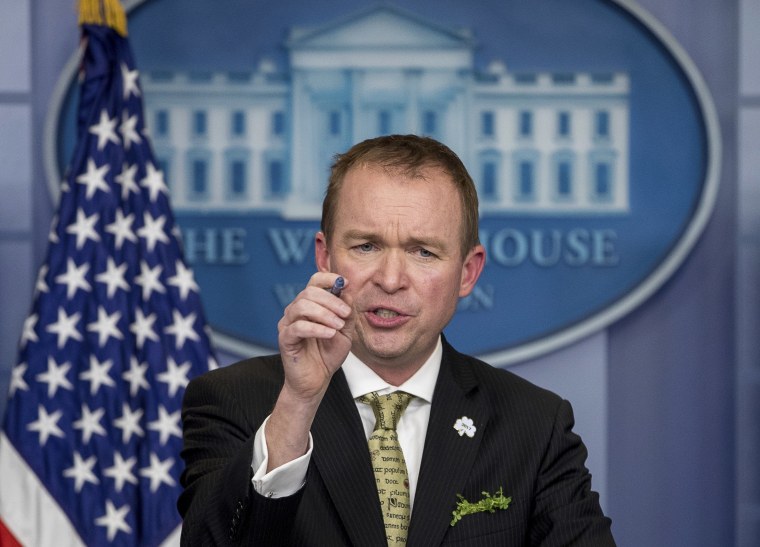The White House released its budget proposal on Thursday, which suggests eliminating the Corporation for Public Broadcasting and the National Endowment for the Arts, among more than 60 agencies and programs, entirely.
Eliminating the Corporation for Public Broadcasting (CPB) would have a far-reaching effect on public television and radio stations across the country, many of which depend on federal funding for everything from children's programming to emergency broadcasting systems and K-12 classroom materials.
Not to mention a dramatic loss of jobs.
According to Patrick Butler, President of America's Public Television Stations, around 23,000 people work in public broadcasting across the U.S., many at small town and rural radio and television stations.
"In the long run it’s entirely possible that everybody would lose his or her job," Butler told NBC News, "If that funding goes away."
Remote areas will be hit hardest if CPB funding — 70 percent of which goes to local stations — is eliminated. Bill Legere, General Manager of Juneau, Alaska's KTOO, oversees a staff of 24 people that run both the public radio and television stations in the state capitol. Funding from the Corporation for Public Broadcasting makes up about one-third of his budget, but in some smaller towns, CPB grants account for closer to 90 percent of operation costs.
"If you’re in a tiny place like Bethel, the vast majority of the funding comes from CPB," Legere told NBC News. "There would no service there at all without government funding."
In some parts of Alaska, Legere explained, public radio and television stations are the only ones that aren't broadcasting from Russia.
Legere's newsroom is the local Alaskan equivalent of C-SPAN, covering the statehouse on a program called "Gavel to Gavel."
In addition to the proposed federal cuts, Legere said the state senate is proposing to eliminate Alaskan funding too. Losing federal funding would already put several jobs at risk at KTOO, but if both of those sources of support are pulled, said Legere, "It would be the end of the line here."
Besides job losses, the people most likely to be impacted by the federal government eliminating public broadcasting would be children and teachers.
According to a statement issued Thursday by PBS, public television is "America's largest classroom," with 68 percent of all kids aged 2-8 watching and learning from shows like Sesame Street, Thomas and Friends, Arthur, and others.
PBS also operates a web resource for teachers called PBS LearningMedia with lesson builders, quiz templates, and other digital classroom resources that is used by over 1 million educators to teach 40 million children and teens in K-12 classrooms.
Jennifer Crutchfield of WTCI Chattanooga in Tennessee understands the impact of PBS on local kids firsthand. She's one of about 20 employees of the station, where each "wears a few different hats" to provide local programming to a 30-county area with about 1.4 million residents. One of her jobs is to create lesson plans and teach local kids and educators to use them.
“I am covered in sticky kid stuff right now,” Crutchfield laughed, explaining that she'd just finished leading a field trip of local schoolchildren.
"We go to schools all over the counties that we serve and I do professional development with the teachers," said Crutchfield. "Those teachers don’t have a lot of resources."
WTCI serves especially low-income communities where kids tend to fall behind and families spend much of their time in social services offices. The station has used a portion of its PBS funding to create "learning lounges" in social services offices and Head Start programs, where kids can use PBS Playtime pads and iPads that are "loaded with educational programs that help them with all of these educational benchmarks."
About half of WTCI's operating budget comes from Corporation for Public Broadcasting grants.
"60 percent of our kids in this area are not ready for kindergarten," said Crutchfield. "That means 60 percent aren’t working on benchmark levels at 3rd grade, at 5th grade, and then they aren’t ready to enter the workforce."
After years in public broadcasting,this isn't the first time Crutchfield has seen proposed cuts. But this one still makes her nervous.
"I have three teenage boys," she said. "I wake up scared."
Speaking on MSNBC's Morning Joe on Thursday, Office of Management and Budget Director Mick Mulvaney said that cutting public broadcasting was in the best interest of rural and inner-city Americans.
"Can we really continue to ask a coal miner in West Virginia or a single mom in Detroit to pay for these programs?" Mulvaney asked.
West Virginians clapped back in response to Mulvaney's comments on social media Thursday, suggesting that he look into how much public media has done to help the industry's workers.
The West Virginia Public Broadcasting also took to Twitter to highlight the number of stories they've done on local coal miners in a state where Trump won 95 percent of voting counties.
Trump's supporters, in general, do not support defunding public broadcasting.
A bipartisan poll conducted in early 2017 found that 70 percent of Trump voters disapproved of cutting funding for public television.
